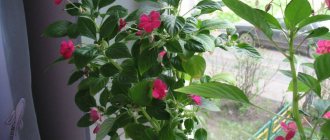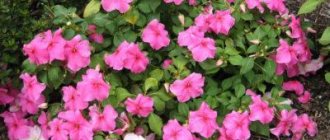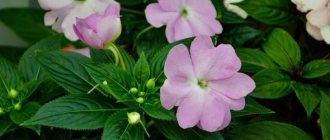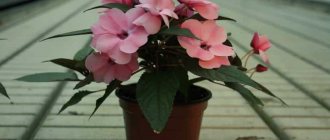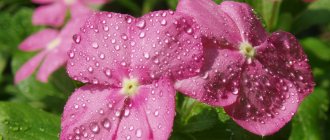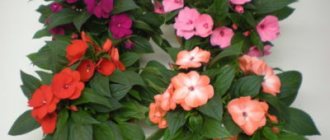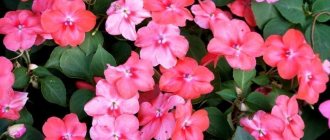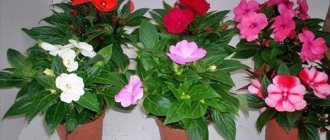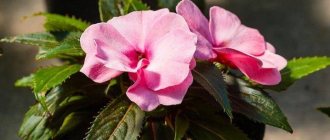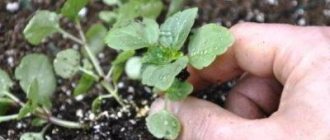Botanical description and history
New Guinea hybrids first appeared on the flower market in 1972. They were bred by crossing the Indonesian variety Hawker with other types of balsam. New Guinea balsam is native to the subtropics and tropics of Africa, Asia and America.
Depending on the place of growth and variety, the flower grows from 30 to 50 cm. The root system is strong and grows well. The plant has the appearance of a bush with many stems .
For oblong-oval pointed leaves:
- bright veins;
- serrated edges;
- short petioles.
Flowers with curly petals can reach a size of 5-7 cm. Depending on the variety, they are one-color or two-color with patterns. At the top of the stems there is one or several buds. Flowering continues for several months, this is influenced by climatic conditions and place of growth.
In place of the flower, a fruit is formed - an oblong capsule . Its outer part is divided by ribs. Once the fruit is ripe, it opens when touched, releasing the seeds. In nature, a flower reproduces this way.
Description
New Guinea balsam grows up to 30-50 centimeters in height.
The root system is powerful and well branched.
The stem is strong and thicker than other types of balsams.
The leaves are lanceolate, up to 5 centimeters wide, with short petioles, reaching a length of up to 10 centimeters. The leaf blades have a serrated edge and prominent deep veins. The color of the leaves varies from light green to dark green with a burgundy tint.
The flowers are five-petaled, up to 5 centimeters in diameter, with elongated shoots on the sides. They bloom alone or in small inflorescences.
After pollination of flowers, oblong seed pods , which, at maturity, burst when touched and release their seeds.
Description of appearance and features
At home, New Guinea balsam can bloom for 10 months. Among gardeners, this property makes the plant very popular.
New Guinea hybrids are distinguished by their power and meatiness . They have strong shoots, bright asymmetrical flowers and very densely spaced leaves. Of the numerous varieties of balsams, these stand out for the beauty of their blooms and the richness of their greenery.
The peculiarities of varietal New Guinea balsam include the fact that the plant sheds its leaves due to:
- hypothermia;
- lack of lighting;
- drying out of the soil.
How the flower will bloom is influenced by the choice of pot, as well as the systematic introduction and composition of fertilizers.
New Guinea hybrids are valued for their colors . Flowers come in different shades:
- pink;
- apricot;
- peach;
- pastel;
- fuchsia, etc.
In addition to the bright dark green color, the leaves are bronze or have a yellowish discoloration in the middle.
Garden and indoor balsam, homeland of the plant, photo, video
The genus Impatiens, which can be translated as “untouchable” or “touchy,” is the basis of the Impatiens family and consists of half a thousand species growing throughout the planet.
Due to the prevalence and diversity of plants, it is impossible to indicate the exact place on the map worthy of being called the birthplace of balsam plants. They are found throughout the world in temperate and tropical regions, but there are several main concentration centers for the species. These are, first of all, Asia and African countries, North America and Europe.
History of the discovery and study of balsams
The acquaintance of botanists with impatiens began in the 17th century. The first information about plants of this genus dates back to 1689 and contains descriptions of some varieties of balsam from India and nearby regions of Asia. Then Carl Linnaeus began studying plants; flower growers owe him the most complete description and systematization of numerous species. But scientists expected the greatest number of discoveries in the world of balsams in the 19th century, when remote corners and countries began to be actively explored. One of the latest additions was a group of New Zealand plants registered in 1989.
The most famous species in our country is Waller's balsam, which grows wild off the east coast of Africa in the Zanzibar archipelago.
It was here that plants new to botanists were discovered in 1861. Several specimens, originally named after a local ruler, were transported to Europe by the British naturalist John Kirk. Here, the attentiveness of the English missionary Horace Waller, who first noticed an unknown plant, and his discovery were appreciated. And the African impatiens received the name Impatiens walleriana in 1896.
The plant is loved by residents of many countries. Today, the continuously blooming indoor balsam is often called Busy Lizzie in the West, and in Russia the culture is called the light Vanka Mokry. Such an unusual, even familiar name is explained by the peculiarity of the plant, which forms small droplets of sweet liquid on the leaves, which over time turn into hard sugar balls.
Among the garden balsams, in the photo, Impatiens balsamina stands out - a small but very attractive native of South Asia, decorating flower beds and borders in many regions of Russia.
In the 20th century, flower growers were able to get acquainted with a large group of hybrids from New Guinea. Now these exotic plants are available to collectors and lovers of indoor plants, and some varieties in mid-latitudes have become so comfortable that they have become real weeds, displacing native species from their usual places.
This fully applies to Himalayan balsam, which a hundred years ago was found only in its homeland.
What does balsam look like?
Among the impatiens or, as they are usually called in Russia, balsams, there are wild, garden and domestic crops. Annual plants in the middle zone are grown as garden balsams, and indoor varieties are crops whose growing season lasts several years.
Thanks to the active breeding work that began in the middle of the last century and the popularization of unpretentious, readily flowering species, balsams have taken their rightful place in the collections of flower growers.
Moreover, they differ so much from each other in the shape and color of flowers, size and habitat that it is difficult to even suspect representatives of different species of belonging to the same genus. Among the balsams there are:
- herbaceous annual plants and perennial varieties that look like small trees or shrubs;
- dwarfs no higher than 20 cm and giants 2 meters high;
- frost-resistant species accustomed to living only in warm tropical climates.
Therefore, the answer to the question: “What do balsams look like?” cannot be simple and monosyllabic.
But with a lot of differences, balsams from different parts of the world also have a lot in common. Plants are called touch-me-nots because of the peculiarity inherent in many varieties. The slightest touch to the juicy fruit-box causes it to instantly open, and the contents scatter with great force over a distance of several meters.
In the plant world, balsams are considered unique record holders for the variety of shapes and colors of corollas.
The flowers of indoor balsam and its garden counterparts can be simple or double, monochromatic or two-color, with a bright contrasting center or a scattering of spots on the petals.
The average diameter of an indoor balsam flower is 2–4 cm, but there are also plants that delight owners with larger, brightly colored corollas. A characteristic feature of the balsam flower is a thin curved spur, but the shape and size of the petals can vary:
- Indoor Waller's balsam has flattened corollas, and the petals that make them up are almost identical.
- In other varieties, due to the shortened asymmetrical petals, the flowers are more reminiscent of violets or snapdragons.
This diversity is associated with different living conditions of plants and which insects participate in pollination.
Features of balsam plants
The vast majority of indoor and garden balsams love shade; there are few exceptions to this rule. First of all, these are plants from New Guinea and, for example, wild balsam glandulifera. But moisture is vital for all impatiens, but moisture-loving species have to protect flowers and leaves from excess water.
The smooth lanceolate leaves of balsams are not distinguished by a variety of shapes, but can have either a single or variegated color. Interestingly, thanks to the special coating on the surface of the sheet plate, drops roll off it, and the sheet remains dry even in heavy rain. The underside is protected from getting wet and rotting by a mass of tiny air bubbles trapped between the fibers.
The flowers are protected from dew and rain by the pedicels that lengthen as the corolla opens. As a result, the garden balsam flower, as in the photo, bends over, and streams of water cannot wash away the ripe pollen.
Video about balsam and its types
www.glav-dacha.ru
Photo
Next in the photo you can look at the plant and admire the beauty of its flowering.
There are more than 400 types of balsam in nature, but in the Northern Hemisphere the following varieties are common: Garden, Wild, Zheleznokosny or Zhelezisty, Tom Samb, as well as Waller's balsam. Flower growers love to grow double and hanging plant species - they will decorate any area or apartment.
What to do with a flower in winter
For 2-3 cold months, dormant conditions are created for Impatiens neuguinea: the ambient temperature is reduced to 12 °C, the intensity of lighting and watering is reduced. In winter, flowers are not placed near heating devices or in drafts.
The dormant period is a very good time to prune flowers. This will make it possible to propagate hybrids by rooting cut stems. In addition, plants are cut from spring and summer, but in this case, pruning can cause the impatiens to shed flower ovaries.
Landing
Can the plant be planted in the garden?
New Guinea balsam is one of the easiest plants to care for , both on the windowsill in the apartment and in the garden. It can withstand short drying and waterlogging of the soil.
Important! It must be borne in mind that in this case the decorative effect of the flower, the density of the leaves and the number of developing buds suffer.
Lighting and location
New Guinea balsam prefers soft, diffused light . It should not be exposed to direct sunlight. The best location for the flower is the window sills facing west and east. In winter, when daylight hours become shorter, the plant requires additional lighting. Otherwise, its shoots will stretch out and the leaves will begin to fall off.
Soil requirements
The flower grows well in light, fertile soil. You can purchase a ready-made substrate or prepare it yourself by mixing:
- Fertile soil.
- Leafy soil.
- Peat.
- Humus.
- Sand.
The self-prepared mixture must be disinfected.
Saving New Zealand balsam and fuchsia
Why does the mother bush of New Zealand balsam die in winter, while varietal fuchsias shed their leaves at this time, being in a cool room?
New Zealand balsam and hybrid fuchsia should overwinter in cool conditions at a temperature of 10°C. But it is impossible to maintain such a temperature at home, and plants can easily be content with temperatures up to 16°C. At the same time, they are placed closer to the window glass so that there is more light.
Water once every 7-10 days, but the earthen ball should not be completely dried out. The roots are very sensitive to lack of moisture and die. A decrease in temperature below 8°C also leads to this result.
Some leaves fall off as the plants rest. But complete loss of leaves at this time of year is a bad sign. This occurs if the air temperature is too high or there is not enough light and water. Overmoistening the soil in winter in cool conditions is also harmful - it leads to rotting of the roots, shedding of leaves and death of the plant.
When there are no conditions for a cool winter, watering is also reduced and watered after the top layer of soil in the flowerpot has dried. On cloudy days, additional lighting is turned on for 10-12 hours. The resulting buds are removed so as not to weaken the plant.
Trim or shorten shoots that are too elongated. Do not feed until sunny weather sets in in the spring.
Varietal fuchsias are more pampered than simple ones and are less resistant to both drying out and overwatering of the soil. Therefore, they cannot withstand poor conditions and die.
In summer, fuchsia and balsams do not like heat above 25°C. Therefore, it is better to grow them in the garden or on a loggia, in partial shade, where there is a lot of fresh air and a light breeze. Fuchsias are responsive to daily spraying with water.
indoor.usadbaonline.ru
Flower care at home
How to care for a flower?
For normal growth at home, indoor New Guinea balsam requires certain care. The temperature should be 18°C…24°C . The flower has a negative effect:
- temperature below 10 °C;
- frosty air;
- drafts.
Therefore, it should not be placed on the windowsill in the kitchen, because there the windows are often opened for ventilation.
The plant needs to be watered regularly, abundantly, but only after the top layer of soil has dried. This will prevent rot from appearing. In winter, watering is reduced to twice a month , the water flowing into the pan should be poured out.
These plants come from the tropics with high humidity, so when the air is dry they can drop buds and flowers.
Regular spraying will help create optimal humidity in the room, with the exception of flowers and buds.
This procedure is especially necessary in extreme heat and with the onset of the heating season. The leaves of the flower can be wiped with a damp sponge, thereby removing the layer of dust and allowing them to breathe freely.
Abundant flowering is impossible without feeding. Twice a month, New Guinea balsam is fertilized with mineral compounds with potassium. This element contributes to the formation of flowers. There is no need to feed with pure nitrogen, due to which the green mass will actively grow and flowering will slow down.
New Guinea balsam does not tolerate pruning . If you want the bushes to look denser and more compact, you can pinch the tops of the shoots. Although the plant itself is able to form a magnificent shape. To create the appearance and shape of the bush, pruning of only the Harmony type is allowed.
The flower must be replanted once every 2-3 years. This is done in the spring. You need to take a small pot, both in diameter and depth. In cramped conditions, New Guinea balsam will grow more luxuriantly. At the bottom, arrange a drainage layer, for example, from expanded clay. The flower must be carefully transferred from pot to pot. Fill the resulting void with soil to such a level that the root neck rises 2 cm above it.
Pruning and replanting
Hybrid varieties, such as New Guinea balsam, do not require regular pruning. To enhance branching, at the owner's request, young tops can be pinched.
Pruning is necessary if the plant has experienced stress, was in a place with poor lighting, or has received excess moisture for a long time. At the same time, its branches stretched out, and the entire bush lost its decorative effect. Such stems are shortened and used for vegetative propagation. When pruning, you need to make sure that the lateral buds remain for the growth of branches.
Balsam transplant:
- The transplantation process is carried out for plants that are grown indoors.
- Impatiens grows and develops quickly, so it is necessary to change the soil every year.
- Transplantation is carried out during the dormant period, when all the flowers have fallen.
- Before you remove the rhizomes, you need to water the soil well.
- A pot is first prepared, the diameter of which is slightly larger than the old one.
- The soil selected is loose, breathable and fertile. You can purchase it at a specialty store or make it yourself. To do this, turf soil is mixed with leaf soil and humus, peat and expanded clay are added.
- The flower is carefully removed along with the earthen lump from the old pot, and the root system is cleared of soil.
- Each part is inspected for diseases, rot and dry areas, which are removed with a sharp knife.
- Drainage and a little prepared soil are poured into the bottom of the new pot.
- Next, you need to place the root system, placing each branch around the perimeter of the bottom of the container.
- The substrate is poured up to the level of the root collar and compacted.
- The first watering is carried out with a weak solution of manganese for additional disinfection.
Common diseases and pests
In most cases, New Guinea balsam gets sick from improper care. This is evidenced by the external state of its parts. When exposed to direct sunlight, yellow spots appear on the leaves. This means that the flower has received burns.
It happens that when the heating is turned on, balsam leaves begin to :
- let the edges dry;
- wither;
- fall off
You need to install special trays with water and expanded clay or install a humidifier. If the always colorful leaves turn pale, this indicates a lack of nutrients. The application of complex fertilizers will help them become bright again.
The following leads to rotting of the root system and stems of New Guinea balsam, and subsequently to fungal diseases:
- excessive watering;
- soil waterlogging;
- too damp air.
The flower can suffer from insect pests: aphids and spider mites. Infected New Guinea balsam must be isolated. Treatment is carried out with special drugs. They treat the flower itself and the ground.
A little about this amazing plant
The herbaceous plant that we want to tell you about belongs to the genus Impatiens, which was not named so by chance. All its representatives have one unique feature - at the slightest touch to their seed pod, it bursts with a bang, and the seeds scatter within a radius of 2 meters.
The genus of balsams is numerous, it includes about 500 species of plants, including New Guinea balsam. Today we will talk about it in more detail.
New Guinea balsam.
This plant is a real miracle, because if you provide it with good care, it will delight you with its flowering for six or even eight months a year. New Guinea balsam differs from other balsams in its thick stem, more powerful leaves and flowers. It has a more compact size, which allows it to be grown in small rooms.
Guinea balsam is more resistant to pathogens and parasites, and is more hardy. As a result of the painstaking work of breeders, flower growers are presented with different species that differ in the color of leaves and flowers, as well as the duration of their flowering. Caring for them is the same as for most balsams.
Features of reproduction
Under natural conditions, balsam propagation occurs using seeds. It is difficult to grow a flower at home this way.
Seeds
According to statistics, out of 10 sown seeds, only 5 germinate. You must also keep in mind that young plants obtained from seeds develop slowly ; the slightest reason can lead to their death.
First you need to prepare fertile soil on which to carefully spread the seeds. After this, sprinkle them with a small layer of earth. Then moisten using a spray bottle or watering can with a spray bottle.
All this must be covered with a transparent film or glass to create a greenhouse effect. It is necessary to systematically open the container to ventilate and moisten the soil, preventing the earthen clod from drying out. The appearance of the first shoots can be expected in 1.5-2 weeks.
Cuttings
The most effective method of propagating New Guinea balsam is cuttings. To do this, below the node, you need to cut off the stalk on which you want to remove the lower leaves. Plant it in prepared soil. It is necessary to place the cutting in a warm place where there is no draft and where direct sunlight does not penetrate. Roots form after 14 days .
In indoor conditions, New Guinea balsam lives for 4-5 years, then it needs to be renewed. When grown in open ground, the plant becomes an annual.
Impatiens is a flower that, although it does not smell, stands out for its magnificent blooms. It is widely used in landscaping personal plots. With the help of New Guinea balsam flowers of different colors, landscape designers create picturesque and unique compositions.
Temperature
During the warm period, balsam is suitable for any temperature for growth and flowering. Sudden changes can seriously damage the plant. The winter period should pass at a temperature not lower than +12-16 degrees.
- The plant will be comfortable where it is warm. The subtropical plant has already adapted to our conditions, but still tolerates the cold with great difficulty. Therefore, in winter the room should be at least 13-16C, and in summer - 20-24C.
- Impatiens love humidity, so if the thermometer needle rises above 22C, it is worth increasing the humidity in the room. Otherwise the flowers will dry up. It is recommended to place a container of water next to the pot.
- In the warm season, the plant does not make any special demands on the surrounding temperature, except that sudden changes can affect it. In winter, it prefers a slightly lower temperature within +12-16 degrees.
In spring and summer, balsam tolerates temperatures of +25 degrees and above, provided there is fresh air and a moist substrate. In winter, the temperature should not fall below +10 +15 degrees. Indoor balsam prefers moderate humidity, but only until the thermometer readings exceed +22 degrees. Increasing the temperature above this value can lead to rapid evaporation of moisture, causing the balsam to wilt. Spraying, which is done carefully, trying not to get on the flowers and buds, will help save the situation.
